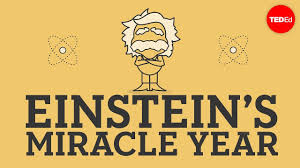(单词翻译:单击)
As 1905 dawned, the soon-to-be 26-year-old Albert Einstein faced life as a failed academic.
随着1905年的到来,即将26岁的阿尔伯特爱因斯坦是以一个挂科的大学生的身份面对生活的。
Most physicists of the time would have scoffed at the idea that this minor civil servant could have much to contribute to science.
如果说这个不起眼的公务员将对科学做出巨大贡献,当时的大多数物理学家一定会加以嘲笑。
Yet within the following year, Einstein would publish not one, not two, not three,
然而在接下来的一年里,爱因斯坦发表了不止一篇,不止两篇,不止三篇,
but four extraordinary papers, each on a different topic,
而是四篇课题各不相同却都非同凡响的论文,
that were destined to radically transform our understanding of the universe.
它们注定将彻底改变我们对宇宙的认识。
The myth that Einstein had failed math is just that.
这也就是为什么爱因斯坦数学挂科了。
He had mastered calculus on his own by the age of 15
他15岁时已经自己掌握了微积分,
and done well at both his Munich secondary school and at the Swiss Polytechnic,
并且在慕尼黑中学和瑞士理工学院都有不错的表现,
where he studied for a math and physics teaching diploma.
他在这两所学校获得了数学和物理教学学位。
But skipping classes to spend more time in the lab
但是为了更多地待在实验室里而翘课,
and neglecting to show proper deference to his professors had derailed his intended career path.
并忽视了对教授表示应有的尊重,这让他偏离了预期的职业道路。
Passed over even for a lab assistant position,
连一个实验室助理的职位都不被考虑,
he had to settle for a job at the Swiss patent office, obtained with the help of a friend's father.
他只好在一位朋友的父亲的帮助下,在瑞士专利局谋了一份工作。
Working six days a week as a patent clerk, Einstein still managed to make some time for physics,
尽管作为一个专利审查员一周要工作六天,爱因斯坦仍然能给物理学留出一些时间,
discussing the latest work with a few close friends, and publishing a couple of minor papers.
与几个好友讨论最新的著作,并发表一些不怎么重要的论文。
It came as a major surprise when in March 1905 he submitted a paper with a shocking hypothesis.
令人大吃一惊的是,他在1905年三月发表了一篇有着惊人假设的论文。
Despite decades of evidence that light was a wave,
不顾几十年来可以证明光是波的证据,
Einstein proposed that it could, in fact, be a particle,
爱因斯坦提出,光,实际上可以是粒子,
showing that mysterious phenomena, such as the photoelectric effect, could be explained by his hypothesis.
并表明一些神秘的现象,比如光电效应,可以用他的假说来解释。
The idea was derided for years to come, but Einstein was simply twenty years ahead of his time.
这个观点在接下来的几年里一直被嘲笑,但爱因斯坦只是领先了他的时代二十年。
Wave-particle duality was slated to become a cornerstone of the quantum revolution.
波粒二象性被载入史册,成为量子革命的奠基石。
Two months later in May, Einstein submitted a second paper,
两个月之后,爱因斯坦提交了第二篇论文,
this time tackling the centuries old question of whether atoms actually exist.
这次他研究的是延续了几个世纪的古老命题--原子是否存在。
Though certain theories were built on the idea of invisible atoms,
尽管某些理论是建立在不可见的原子概念上的,
some prominent scientists still believed them to be a useful fiction, rather than actual physical objects.
一些杰出的科学家还是认为比起真实的物理对象,原子更像是一个有用的假设。

But Einstein used an ingenious argument, showing that the behavior of small particles randomly moving around in a liquid,
但是爱因斯坦用了一个独创的论点,展示了微小粒子的运动,小分子在液体中的不规则运动,
known as Brownian motion, could be precisely predicted by the collisions of millions of invisible atoms.
也就是布朗运动,可以被准确的预测,因为它是通过数以百万计的不可见的原子互相撞击而形成的。
Experiments soon confirmed Einstein's model, and atomic skeptics threw in the towel.
不久,实验就证明了爱因斯坦的模型,原子论的怀疑者也拱手认输。
The third paper came in June.
第三篇论文发表于六月。
For a long time, Einstein had been troubled by an inconsistency between two fundamental principles of physics.
在很长一段时间里,爱因斯坦一直被物理学中两个基础原理的不一致所困扰。
The well established principle of relativity, going all the way back to Galileo, stated that absolute motion could not be defined.
在两个基础的物理原理间,被广泛接受的相对性原理,在伽利略时期就已经被确立,它阐明绝对的运动是无法定义的。
Yet electromagnetic theory, also well established, asserted that absolute motion did exist.
然而同样被广泛接受的电磁理论,则声称绝对的运动是存在的。
The discrepancy, and his inability to resolve it, left Einstein in what he described as a state of psychic tension.
这个矛盾和自己的无能为力,使爱因斯坦陷入了被他称作精神紧张的状态。
But one day in May, after he had mulled over the puzzle with his friend Michele Besso, the clouds parted.
但是五月的一天,在和他的朋友米歇尔·贝索探讨这个谜题后,爱因斯坦感到云开雾散。
Einstein realized that the contradiction could be resolved if it was the speed of light that remained constant,
爱因斯坦意识到,这个矛盾是可以化解的,即如果光速是恒定的,
regardless of reference frame, while both time and space were relative to the observer.
不论它处于何种参考系中,而时间和空间对于观测者都是相对的。
It took Einstein only a few weeks to work out the details and formulate what came to be known as special relativity.
爱因斯坦只用的几周时间就完成了细节,并用公式表达出了后来被称作狭义相对论的内容。
The theory not only shattered our previous understanding of reality but would also pave the way for technologies,
这个理论不仅粉碎了我们之前对现实的认识,还为技术发展铺平了道路,
ranging from particle accelerators, to the global positioning system.
从粒子加速器到全球定位系统。
One might think that this was enough, but in September,
你也许认为这已经足够了,但是在九月,
a fourth paper arrived as a 'by the way' follow-up to the special relativity paper.
第四篇论文以狭义相对论论文的后续的方式诞生了。
Einstein had thought a little bit more about his theory, and realized it also implied that mass and energy,
爱因斯坦进一步思考了他的理论,然后意识到它还暗示了质量和能量,
one apparently solid and the other supposedly ethereal, were actually equivalent.
一个是明显实体的,另一个被认为是飘渺的,实际上是等价的。
And their relationship could be expressed in what was to become the most famous and consequential equation in history: E=mc^2.
它们的关系可以用一个很著名的方程式来表达,这个方程式而后也成为了历史上最重要的方程式之一:E=mc^2。
Einstein would not become a world famous icon for nearly another fifteen years.
爱因斯坦在接下来的近15年里都没有成为举世闻名的偶像。
It was only after his later general theory of relativity was confirmed in 1919
直到1919年确认了他后来的广义相对论,
by measuring the bending of starlight during a solar eclipse that the press would turn him into a celebrity.
通过测量星光在日全食中的弯曲,媒体才把他变成了一个名人。
But even if he had disappeared back into the patent office and accomplished nothing else after 1905,
但是尽管他随后就回到专利局里销声匿迹,并在1905年之后一无所成,
those four papers of his miracle year would have remained the gold standard of startling unexpected genius.
他在他那奇迹般的一年里写出的4篇论文,依旧使他成为令人震惊的天才。


